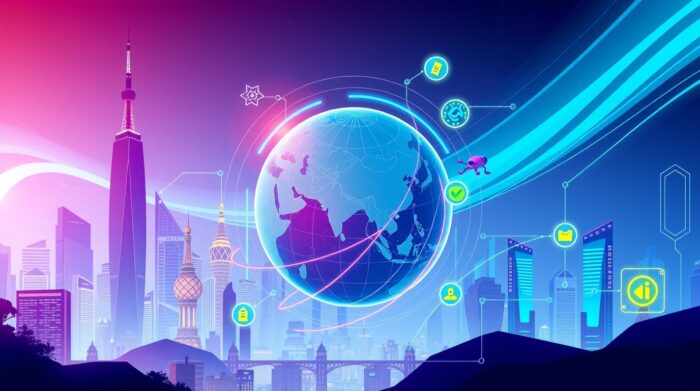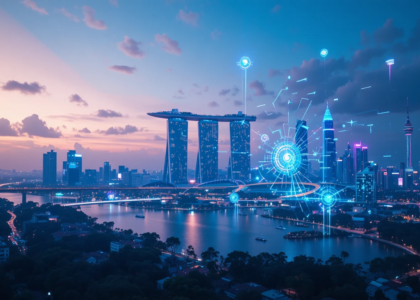The Rise of AI Content in Asia
Asia stands at the forefront of a creative revolution powered by AI Content Generation. Across industries—from marketing and journalism to fintech and education—AI is transforming the way content is conceived, crafted, and consumed. What once took weeks of human effort can now be achieved in minutes, without compromising quality or cultural nuance.
The region’s appetite for innovation is unparalleled. Markets like China, India, and Japan are redefining what it means to create and communicate at scale. Artificial intelligence is not just an enabler of efficiency; it’s the silent strategist behind a new wave of intelligent storytelling. In a landscape as diverse as Asia, where over 2,000 languages converge, AI has become the great connector—breaking linguistic barriers while maintaining local authenticity.
This evolution isn’t about replacing human creativity but enhancing it. AI brings speed, scale, and insight, while humans bring empathy, context, and vision. Together, they’re forming an alliance that’s changing the nature of communication itself. Asia’s story is no longer written by hand alone—it’s co-authored with code.

Asia’s Unique Digital Landscape and AI Adoption
Asia’s digital ecosystem is as dynamic as it is diverse. The continent is home to some of the world’s fastest-growing internet populations and most tech-forward economies. From the bustling digital marketplaces of India to the high-tech innovation hubs of South Korea and Japan, AI Content Generation is finding fertile ground.
Governments across the region are investing heavily in AI strategies, fostering environments that accelerate adoption. Singapore’s Smart Nation initiative, for instance, aims to infuse AI into every layer of society, while China continues to dominate global AI research and deployment. These policies aren’t just driving innovation—they’re creating ecosystems where data, creativity, and machine intelligence merge seamlessly.
Asia’s mobile-first audience further accelerates this trend. With billions consuming content on smartphones daily, the demand for fast, personalized, and culturally resonant content has never been greater. AI meets that demand by automating creation while ensuring each message aligns with local sensibilities. In this fast-evolving landscape, AI isn’t a luxury—it’s the new standard for survival and success.

Multilingual Capabilities: Bridging Linguistic Diversity
Few regions embody linguistic diversity like Asia. From Hindi and Mandarin to Bahasa, Japanese, and countless dialects, the continent is a tapestry of languages and cultures. For brands seeking to connect authentically, that diversity has long been a challenge—until AI Content Generation entered the scene.
AI now empowers organizations to communicate across borders with precision and emotion. Advanced language models can not only translate but also localize—capturing tone, idioms, and cultural cues. A campaign written for a Korean audience can be reimagined for Thai consumers without losing its heart or message. This level of multilingual agility is transforming regional marketing and diplomacy alike.
The technology goes beyond simple translation. It learns from engagement data, understanding what resonates in different cultures and adapting accordingly. This is particularly critical in Asia, where cultural sensitivity can make or break a brand. Through multilingual AI, connection becomes effortless, and every story can find its audience—no matter the language.

Speed and Efficiency: Transforming Content Production Workflows
In the modern economy, speed is everything. The faster a company can move from concept to execution, the greater its competitive edge. AI Content Generation provides that edge by drastically reducing production timelines without sacrificing creativity.
AI tools are now integral to content workflows across Asia. They draft, edit, optimize, and personalize with remarkable accuracy. What used to take teams days to research, write, and polish can now be generated in hours—freeing human creatives to focus on storytelling and strategy. It’s not just about doing more; it’s about doing better, faster.
This shift is redefining productivity. Brands can now maintain real-time engagement with their audiences, responding instantly to trends and cultural moments. The result is a new rhythm of creation—fluid, responsive, and endlessly scalable. AI doesn’t just speed up content production; it reimagines what’s possible when technology and creativity work in sync.
Cultural Sensitivity and Local Relevance in AI-Generated Content
For all its power, AI’s true potential lies in its ability to understand people. Cultural relevance is the heartbeat of Asian storytelling, and AI Content Generation is evolving to honor that truth.
Modern AI tools are being trained on regional data to grasp local idioms, humor, and sentiment. A campaign targeting Japan must feel respectful and refined, while one for the Philippines should carry warmth and community spirit. These subtleties make or break communication—and AI is learning to master them.
By fusing linguistic intelligence with emotional intelligence, AI can now produce messages that resonate authentically within each culture. This level of localization transforms generic marketing into deeply human storytelling. As Asia continues to set the global tone for digital creativity, culturally sensitive AI will ensure that progress never loses touch with people.
Case Studies: Success Stories of AI Content Generation in Asia
Across Asia, the success stories of AI Content Generation are multiplying. E-commerce leaders use AI to craft millions of personalized product descriptions that adapt to each shopper’s behavior and language. Media companies deploy AI to summarize breaking news and generate multilingual reports in real time. Startups, meanwhile, are leveraging AI-driven storytelling to compete with global giants.
These examples illustrate a clear trend: AI is no longer just a technological advantage—it’s a strategic asset. In India, content agencies are using AI to write scripts for advertising and social media campaigns. In Indonesia, local brands rely on it to manage multilingual marketing at scale. In Japan, corporations integrate AI to produce corporate communications that maintain brand voice across all divisions.
Each success underscores a powerful truth: when creativity meets computation, boundaries vanish. The future of content in Asia isn’t theoretical—it’s already here, and it’s powered by intelligence that learns, adapts, and creates alongside us.

Challenges and Ethical Considerations
No technological leap comes without questions of responsibility. The rise of AI Content Generation brings with it complex ethical challenges—bias, authenticity, and ownership chief among them. Who truly “owns” an AI-created story? How do we ensure AI-generated narratives remain accurate, fair, and culturally respectful?
These are questions Asia’s innovators are actively addressing. Governments are beginning to introduce ethical AI guidelines that prioritize transparency, fairness, and accountability. The private sector, too, is embracing responsible AI frameworks to ensure technology enhances, rather than exploits, creativity.
Ethics must evolve alongside innovation. The promise of AI lies not in replacing humans, but in empowering them. To achieve that, the focus must remain on collaboration—machines amplifying human talent, not overshadowing it. Asia’s success in this arena will depend on its ability to blend progress with principle, creativity with conscience.
Conclusion: The Future of AI Content Generation in Asia
The next chapter of Asia’s digital evolution is being written not by human hands alone, but through collaboration between imagination and machine intelligence. AI Content Generation stands at the center of this transformation—fast, multilingual, and deeply impactful.
In the years ahead, we’ll see content that not only speaks every language but understands every culture. We’ll see brands that tell stories in real time, fueled by data yet rich in emotion. And we’ll see creators—human and artificial—working together to redefine creativity itself.
Asia’s creative renaissance has begun. The tools are here, the talent is ready, and the possibilities are infinite. The question now is not whether AI will shape the region’s future—but how boldly Asia will shape the future of AI.





